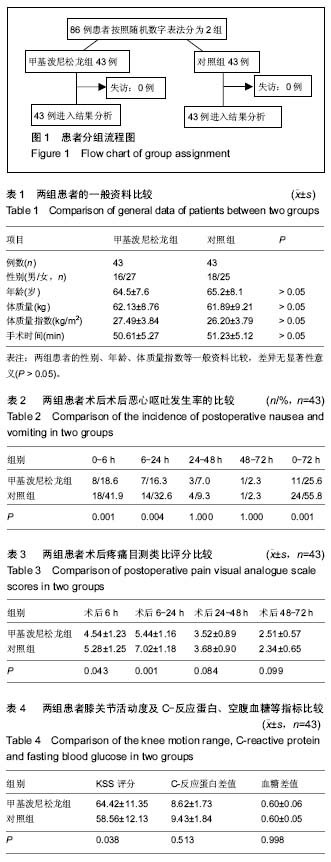| [1] Koh IJ, Kim TK,Chang CB, et al.Trends in use of total knee arthroplasty in Korea from 2001 to 2010.Clin Orthop Relat Res. 2013;471(5):1441-1450.[2] Hahm TS,KoJ S, Choi SJ,et al.Comparison of the prophylactic antiemetic efficacy of ramosetron and ondansetron in patients at high-riskfor postoperative nausea and vomiting after total knee replacement.Anaesthesia.2010;65(5):500-504.[3] Parvizi J, Miller AG, Gandhi K,et al.Multimodal pain management aftertotal joint arthroplasty.Bone Joint SurgAm. 2011;93(11):1075-1084.[4] DiIorioTM,Sharkey PF, Hewitt AM, et al. Antiemesis after total joint arthroplasty: does a single preoperative dose of aprepitant reduce nausea and vomiting? ClinOrthop Relat Res.2010;468(9):2405-2409.[5] Joo J, Park YG, Baek J,et al.Haloperidol dose combined with dexamethasone for PONV prophylaxis in high-risk patients undergoing gynecological laparoscopic surgery: a prospective, randomized,double-blind,dose-response and placebo-controlled study.BMCAnesthesiol.2015;15:99.[6] Rytter S, Stilling M, Munk S, et al. Methylprednisolone reduces pain and decreases knee swelling in the first 24 h after fast-track unicompartmental knee arthroplasty.Knee Surg Sports Traumatol Arthrosc.2015.[7] Lunn TH, Kristensen BB, Andersen LØ, et al. Effect of high-dose preoperative methylprednisolone on recovery after total hip arthroplasty: a randomized, double-blind, placebo-controlled trial.BrJ Anaesth.2013;110(1):66-73. [8] Gan TJ, Meyer T, Apfel CC, et al. Consensus guidelines formanaging postoperative nausea and vomiting. Anesth Analg.2003;97(1):62-71.[9] FujiiY, Tanaka H. Prevention of nausea and vomiting with ramosetron after total hip replacement. Clin Drug Investig. 2003;23(6): 405-409.[10] Apfel CC,Heidrich FM,Jukar-Rao S, et al. Evidence- basedanalysis of risk factors for postoperative nausea and vomiting.Br J Anaesth.2012;109(5):742-753.[11] Macario A, Weinger M, Truong P, et al. Which clinical anesthesia outcomes are both common and important to avoid?The perspective of a panel of expert anesthesiologists. Anesth Analg.1999;88(5):1085-1091.[12] Phillips C, Brookes CD, Rich J, et al. Turvey. Postoperative nausea and vomiting following orthognathic surgery.Int J Oral Maxillofac Surg.2015;44(6):745-751.[13] 蔡迎春,谢锦伟,马俊,等.全身麻醉下初次髋、膝关节置换术后恶心呕吐危险因素的回顾性分析[J].中华骨与关节外科杂志,2016, 9(1): 35-39.[14] Fujii Y. Current review of ramosetron in the prevention ofpostoperative nausea and vomiting. Curr Drug Saf. 2011; 6(2):122-127.[15] Myklejord DJ, Yao L, Liang H,et al. Consensus guidelineadoption for managing postoperative nausea and vomiting.WMJ.2012;111(5):207-213,214.[16] Vieira PA, Pulai I, Tsao GC, et al. Dexamethasone with bupivacaine increases duration of analgesia in ultrasound- guided interscalene brachial plexus blockade. Eur J Anaesthesiol. 2010;27(3): 285-288.[17] Smith HS, Smith EJ, Smith BR, et al. Postoperative nausea and vomiting. AnnPalliat Med.2012;1(2):94-102.[18] KohI J,Chang CB,Lee JH,et al.Preemptivelow-dose dexamethasone reduces postoperative emesis and pain after TKA: arandomizedcontrolledstudy. Clin Orthop Relat Res. 2013;471(9):3010-3020.[19] 张大志,王怀江,刘永盛,等.不同剂量地塞米松对罗哌卡因神经阻滞作用的影响[J]. 临床麻醉学杂志.2013,(03):213-215.[20] Backes JR,Bentley JC,Politi JR,et al.Dexamethasonereduces length of hospitalization and improves postoperative pain and nausea aftertotaljointarthroplasty:aprospective,randomized controlled trial.J Arthroplasty.2013;28(8 Suppl):11-17.[21] Berjis N, Soheilipour S, Musavi A, et al. Intratympanic dexamethasone injection vs methylprednisolone for the treatment of refractory sudden sensorineural hearing loss. Adv Biomed Res.2016;5:111.[22] Annane D,Bellissant E, Bollaert PE, et al. Corticosteroids in the treatment of severe sepsis and septic shock in adults:a systematic review. JAMA.2009;301(22):2362-2375.[23] Weren M, DemeereJL,et al.Methylprednisolone vsdexamethasone in the prevention of postoperativenausea and vomiting: a prospective, randomised,double-blind, placebo-controlled trial.Actaanaesthesiologica Belgica. 2008;59:1-5.[24] LunnTH, Kristensen BB, Andersen LØ, et al. Effect of high-dosepreoperative methylprednisolone on pain and recovery after total kneearthroplasty: a randomized, placebo-controlled trial.BrJAnaesth.2011;106(2):230-238.[25] Miyagawa Y, Ejiri M, Kuzuya T. et al. Methylprednisolone reduces postoperative nausea in total knee and hip arthroplasty.J Clin Pharm Ther.2010;35(6):679-684.[26] Aminmansour B, Khalili HA, Ahmadi J, et al.Effect of highdose intravenous dexamethasone on postlumbar discectomy pain. Spine.2006;31(21):2415-2417.[27] Salerno A, Hermann R. Efficacy and safety of steroid use for postoperative pain relief.Bone Joint Surg Am.200688:1361- 1372.[28] Jules-Elysee KM, Wilfred SE,Memtsoudis SG, et al.Steroid modulation of cytokine release and desmosine levels in bilateral totalknee replacement: a prospective, double-blind, randomized controlled trial.J Bone Joint Surg Am.2012; 94(23):2120-2127.[29] 俞磊,张成欢,包倪荣,等. 静脉应用糖皮质激素改善膝关节置换术后PONV和疼痛的meta分析[J] .临床与病理杂志,2015,35(11): 1985-1991. |
.jpg)

.jpg)